Current as of: January 11, 2026 - 20:38
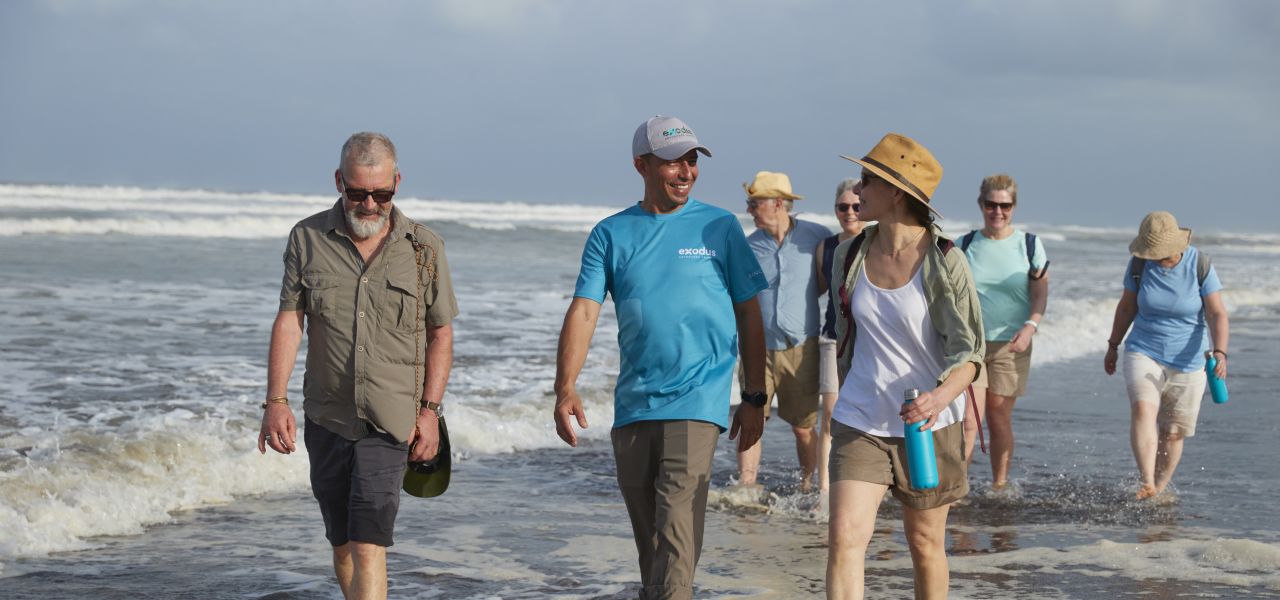
Costa Rica's Coastal Secrets Trip Notes
- Ways to Travel: Guided Group
- Destination: Costa Rica
- Programmes: Wildlife
-
Activity Level:
2 out of 7 - Easy & Moderate
- 15 Days: Land Only
- Ages: 16+
- Trip Code: WUR
- Carbon Footprint: 21kg CO2e
Trip Overview
Explore lesser-known habitats in search of astonishing animal encounters: sloths, sharks, monkeys and more
Discover Costa Rica’s greatest wildlife-watching secrets: the hidden animal hotspots of the Caribbean and Pacific coasts. Led by an expert tour leader, we seek extraordinary encounters, including cruising the Tortuguero waterways in search of monkeys, caiman and birds, hiking Corcovado National Park while looking for sloths, scarlet macaws and more, and snorkelling with turtles, manta rays and sharks off Caño Island.
At a Glance
- Accommodation: 14 Classic nights (3 hotel, 11 lodge)
- Travel by minibus and boat
- Group normally 4 to 16, plus leader. Minimum age: 16
- Green turtle nesting season: July to October
Highlights
- Explore the lesser-visited wildlife hotspots on Costa Rica’s Caribbean and Pacific coastlines
- Spend three nights in the remote coastal wilderness of Drake Bay, accessible by boat
- Jump into the Pacific waters near Caño Island to snorkel with sharks, manta rays and turtles
- Experience Corcovado National Park, said to be ‘the most biologically intense place on Earth’
- Navigate the Tortuguero waterways in search of monkeys, caiman and more
- Search for the notoriously shy resplendent quetzal in the Savegre Valley Cloud Forest
Is This Trip for You?
This trip is graded Activity Level 2 (Easy & Moderate) with a Wildlife Rating of Four. Visit our Wildlife Holidays page for more on our Wildlife Ratings. For more information on our trip gradings please visit the Activity Level Guidelines page. If you have any queries about the difficulty of the trip please do not hesitate to contact us.
Driving: Most of the roads we travel on are good quality. However, the road that leads to the river on the way to and from Tortuguero has a poor surface and this can result in slow driving times, particularly following heavy rain. There are also some longer drives on the itinerary; when rest stops and meal breaks are taken into account, a four-hour drive may take six to seven hours in total. Drake Bay and Corcovado National Park on the Osa Peninsula are two of the most remote areas we visit on this itinerary – there is very limited road access or facilities in these areas and we will use boats as the main form of transportation.
Walks: There are several included and optional walks on the itinerary that occasionally involve walking on rough paths. These are suitable for most fitness levels and usually last between two to four hours. Walks in the Savegre Valley are at an altitude above 7,000ft (2,100m) and involve some short but steep sections of ascent and descent. During times of heavy rain, trails can be muddy and slippery and extra care should be taken. Many of the areas visited on the trip are hot and humid (such as Cahuita National Park on days 4-6) and there is the chance of heavy rain year-round – this is why Costa Rica is so green.
Swimming: The sea waters in the Tortuguero and Cahuita regions have very strong rip currents and are not suitable for swimming from the beach.
Water safety: This trip includes time by a lake, river or sea, where there may be opportunities to swim. You should always seek local advice before deciding whether to swim. Open-water or wild swim spots should be treated with extreme caution. Information on how to keep yourself safe while swimming is shown here.
Adult min age: 16
Min group size: 4
Max group size: 16
Itinerary
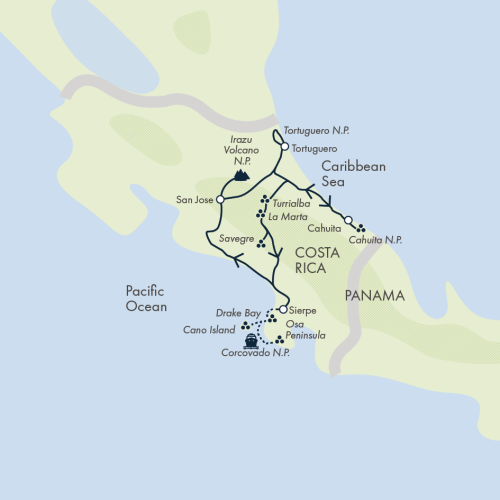
Land Only
- Start City: San José
- End City: San José
Land Only Itinerary
Begin your adventure in San José, the culture-rich capital of Costa Rica. A complimentary transfer from the airport to the hotel is available. Check in and take it easy, there’s plenty of excitement on this trip, so today’s all about relaxing and easing ourselves into the adventure.
Around 7.30pm, say hola to your tour leader and fellow travellers when we gather as a group for a short briefing and dinner together. Our main briefing takes place tomorrow afternoon in Tortuguero due to the late arrival of some flights today.
Want to explore San Jose further? Secure pre-tour hotel nights through your sales representative.
Accommodation: Presidente Hotel (or similar)
Upgrade to a superior room today – speak to your sales representative for more details
Our adventure begins early this morning, leaving San Jose behind as we travel to Tortuguero National Park in northeast Costa Rica. Accessible only by boat or light aircraft, Tortuguero has a vast network of waterways, canals and swamps that are remarkably tranquil, unspoilt and devoid of noise pollution. On reaching the pier, we board a small motorboat for the journey to our lodge (up to 1hr 30min) , which is a short distance from the main lagoon. Please note the transfer from San José to Tortuguero is not private for our groups.
This afternoon your tour leader will host the main welcome briefing when we gather as a group to get to know each other and learn more about the adventures ahead. We also visit Tortuguero village, where it’s possible to enter the Sea Turtle Museum (a donation is requested at the entrance).
Tortuguero is probably most famous as a nesting site for the endangered green turtle, which can be seen coming ashore to lay eggs from late July to October (as part of an optional excursion). Hawksbill, loggerhead, and giant leatherback turtles also nest in this region, and from late August through to November, baby turtles hatch and make their way to the ocean. Today’s travel time will be in the region of six hours including a stop for breakfast.
Accommodation: Aninga Lodge/Evergreen Lodge (or similar)
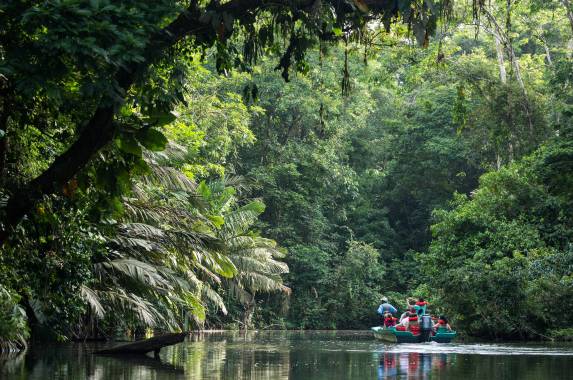
This morning we board a small boat, enabling us to discover the extraordinary flora and fauna of Tortuguero as we pass serenely along the waterways. In the morning wildlife is usually at its most active and with the help of our expert guide we are likely to encounter monkeys, caiman, iguanas, butterflies and many of the 300-plus bird species recorded here. We’ll take a second boat trip this afternoon or you can relax at the lodge and enjoy the facilities.
Accommodation: Aninga Lodge/Evergreen Lodge (or similar)
We leave Tortuguero the same way we arrived, by taking a small boat to Siquirres pier. Our bus will be at the pier waiting to drive us to the Cahuita region on the Caribbean coast, where we check into our hotel. Caribbean culture pervades this part of Costa Rica and is reflected in the music, food and laid-back lifestyle. The white-sand beach here is fringed by tall palms, behind which is the dense, wet tropical forest of Cahuita National Park.
Accommodation: Ciudad Perdida (or similar)
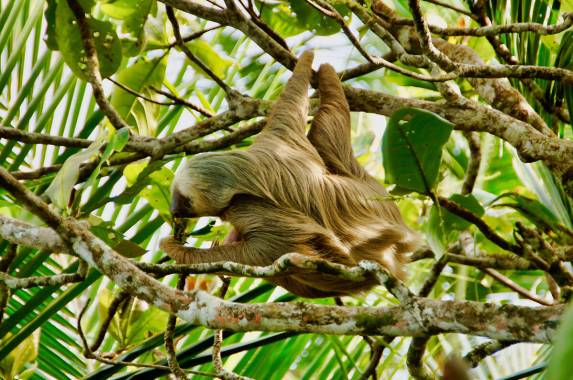
Cahuita National Park has 2,711 acres (1,097ha) of land and 600 acres (243ha) of coral reef, the largest reef system in Costa Rica. Today we visit the national park, taking a walk that follows the coastline through rainforest and past impressive Caribbean beaches. Although fairly small in size, there is plenty of diversity in the park. The rest of the afternoon is yours to explore the beach, join an optional snorkelling excursion (subject to local conditions) or simply relax.
Accommodation: Ciudad Perdida (or similar)
Today is yours to relax into the Caribbean pace of life and enjoy free time around Cahuita. It is possible to join an optional excursion to the indigenous communities of Kekoldi & Bri Bri Reserve, where you’ll learn about the properties and uses of native plants, plus the process of making artisanal chocolate. Chocolate is very important in Bri Bri culture and used for purification rituals, food and medicine. During the excursion, there is also the opportunity for a refreshing swim at a waterfall.
Accommodation: Ciudad Perdida (or similar)
Our next destination is Turrialba Valley, a rich agricultural region in the Central Highlands. The topography of this region is mountainous, with waterfalls, rivers and caves – the varied elevation supports a wide range of plants (including orchids, bromeliads, lichens and mosses) and animals (including anteaters, ocelots and tapirs).
In the afternoon, enjoy a guided tour around Aquiares, one of the most prominent coffee estates in Costa Rica. Of course, you’ll learn about the coffee-making process and taste the final product, but the tour also reveals how the Aquiares team is putting a strong emphasis on sustainability by reducing their carbon footprint and supporting the local community.
Accommodation: Villa Florencia (or similar)
Upgrade to a superior room today – speak to your sales representative for more details

After breakfast, we depart for CATIE (Centro Agronómico Tropical de Investigación y Enseñanza), an international institute for agricultural development and biological conservation. Our visit includes a guided walk in the Dr Jorge León Arguedas Botanical Garden, during which we will see and learn about the approximately 400 different species that are observed and interpreted here, as well as receive an explanation of myriad exotic fruits that are found at the facility.
After lunch, we continue to San Gerardo de Dota and Savegre Valley Cloud Forest. This is said to be one of the best places in Costa Rica to see the beautiful, colourful and notoriously shy resplendent quetzal and we have two nights here to discover the region. These endangered birds rely on the cloud forest for their habitat; the males are particularly striking with a green crest, red breast and tail feathers that can reach a metre in length. A good pair of binoculars will be helpful for quetzal spotting as these birds camouflage themselves well among the wet leaves. After lunch, we take a short walk into the cloud forest.
Accommodation: Savegre Hotel, Nature Reserve & Spa or Trogon Lodge (or similar)
Upgrade to a master-suite today – speak to your sales representative for more details
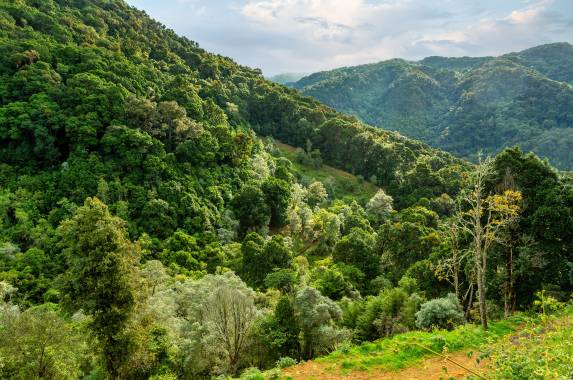
Today is free to relax and explore Savegre Valley. Bring your binoculars to spot some of the 170 bird species, trek through the tropical cloud forest or simply enjoy the incredible view from the lodge. Your leader will suggest walks for today so you can discover the tropical cloud forest and sub-Alpine vegetation of the area. Birds here include hummingbirds, woodpeckers tanagers and trogons, and if you are lucky tapirs and squirrel monkeys.
Accommodation: Savegre Hotel, Nature Reserve & Spa or Trogon Lodge (or similar)
Upgrade to a master-suite today – speak to your sales representative for more details
Early in the morning, our journey continues towards the small town of Sierpe, where we board a small motorboat to Drake Bay on the Osa Peninsula. Passing the huge mangrove swamps that line the Sierpe River, our boat crosses the ocean before arriving at Drake Bay. This region is very remote and with extremely limited road access, which means most supplies, visitors and locals, must arrive by boat. Getting here is part of the adventure. The bay is spectacular, with just a handful of lodges on the horizon and the rest thick verdant forest and rocky coves as far as the eye can see. Our next three nights will be spent at the Drake Bay Wilderness Resort, a family-run property close to the ‘town’ of Drake Bay and with ocean views from every corner.
Accommodation: Drake Bay Wilderness Resort (or similar)
December to August (drier months)
This morning, we board a small boat towards Caño Island. During this 45-minute boat ride, there may be opportunities to spot migrating whales or playful dolphins (orca are occasionally spotted here between December to April and humpbacks might be seen in July and August). Marine life is the biggest highlight of this area, with hawksbill and olive ridley turtles, manta rays and white-tipped reef sharks just some of the likely encounters on today’s snorkelling excursion. This area has been rated as having some of the best snorkelling in Costa Rica, with a huge marine diversity living in the protected reef (visibility subject to weather conditions).
On returning to Drake Bay, we enjoy lunch then embark on a 1mi (1.5km) walk to Cocalito Beach. Wildlife including iguanas, macaws and toucans are often spotted along the route, and elusive tapirs are also seen less frequently. There is time to rest on the golden sands and take in the secluded beauty of Cocalito before returning to the hotel.
September to November (wetter months)
Today we visit a community rural tourism project that has developed to protect the area’s flora and fauna, and provide an economic benefit to the local people. We start the day with a short boat ride to the village of Drake Bay then take a 30-minute transfer to Finca Paz y Flora, home to many bird species who are attracted by the resplendent gardens.
We walk on the Trillo de la Danta, or Tapir’s Trail, within a primary tropical forest. Keep an eye out for collared peccaries, agouti, monkeys and shy tapirs. Towards the end of the walk, we reach a scenic waterfall where it’s possible to cool off with a dip in the clear waters. We enjoy a traditional lunch served in banana leaves before returning to our hotel.
Accommodation: Drake Bay Wilderness Resort (or similar)
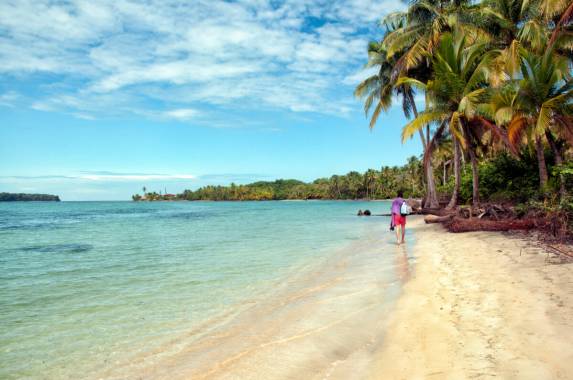
When National Geographic describes an area as “the most biologically intense place on Earth,” it must be worthy of investigation. This morning, we board a small boat for a 30-minute journey to San Pedrillo Ranger Station, our entrance point to Corcovado National Park. This is undoubtedly the most secluded and tranquil region in Costa Rica. Protecting around one-third of the Osa Peninsula (some 164sqmi/425sqkm), Corcovado is the largest national park in Costa Rica and encompasses 13 major ecosystems across various elevations, with montane forest, cloud forest, fresh water and mangrove swamps among them.
Scientists have recorded half of all the species in Costa Rica on this peninsula alone. On today’s hike along the parks trails, we may see all four monkey species in Costa Rica (squirrel, howler, white-faced capuchin and spider), tamandua (anteaters), two- and three-toed sloths, peccary, tapirs (including the endangered Baird’s tapir) and many reptiles, insects and amphibians. Puma and jaguar also prowl this area, but are very difficult to see. With more than 500 tree species, the bird count stands at an impressive 365 and the park protects the largest population of scarlet macaws in the country, which can frequently be seen and heard flying overhead. In October, when the national park is closed, we typically visit El Camino de la Danta, a wildlife-rich trail home to white-faced monkeys, scarlet macaws, toucans and more.
Accommodation: Drake Bay Wilderness Resort (or similar)
After an early breakfast, we board another boat and return to Sierpe town. On the way, our boat will take a short tour of the huge mangrove forest that lines the Sierpe River. Delving into the network of tributary rivers and streams offers a chance to learn more about the role of mangroves in the ecosystem and the numerous creatures that depend on them, including fish, crabs, birds, molluscs and shellfish. In Sierpe town, we transfer to our private minibus and commence our journey to San José.
Accommodation: Presidente Hotel (or similar)
Upgrade to a superior room today – speak to your sales representative for more details
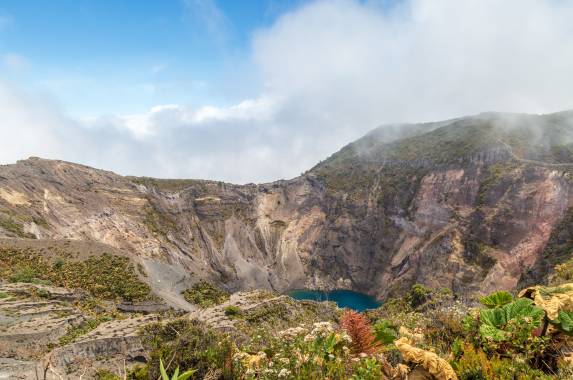
Begin with a trip to Irazu Volcano National Park in the Cartago province, located within the Central Mountain Range around a 90-minute journey from San José. Passing different vegetation, we drive towards the summit and then follow a path that leads to a wonderful view across the huge crater. Irazu is one of the most active volcanoes in Costa Rica, though it has recently entered a dormant phase – a relief to the farmers and property owners who make their living on the fertile slopes. On a clear day, you can see both the Caribbean and Pacific coastlines from the summit. Remember to bring a jacket as it can be windy and cold at the viewpoint of this elevation (Irazu summit is 11,260ft/3,432m high).
After, we continue to Cartago city, home to a spectacular domed basilica, where we have lunch. It’s then back to San José, where we visit Avenida Central and explore the main city highlights. We stop at the Central Market, a lively and traditional space where you can find a variety of local goods, including souvenirs, handicrafts, coffee, and typical Costa Rican snacks – a great spot to pick up gifts.
Accommodation: Presidente Hotel (or similar)
Upgrade to a superior room today – speak to your sales representative for more details
Our adventure comes to an end today after breakfast and it’s time to bid Costa Rica and the rest of the group goodbye.
Alternatively, extend your adventure with a stay at the Punta Leona Beach Club in Jacó, where you can relax on one of two white-sand beaches, treat yourself to some spa time, or join an educational tour through their protected nature reserve, which is home to more than 200 bird species, including toucans, owls and flycatchers. To make things extra relaxing, your booking includes a transfer to the hotel and another at the end of your stay to San José Airport. Speak to your sales representative to book.
Our adventure comes to an end today after breakfast and it’s time to bid Costa Rica and the rest of the group goodbye.
If you aren’t quite ready to leave, speak to your sales representative about extending your adventure – relax on the beach, treat yourself to some spa time, or discover more nature. To ensure total relaxation, you can stay for as many nights as you wish in a range of hotels, and we’ll organise airport transfers in either direction for you.
Post-trip Extensions
Costa Rica Hotels
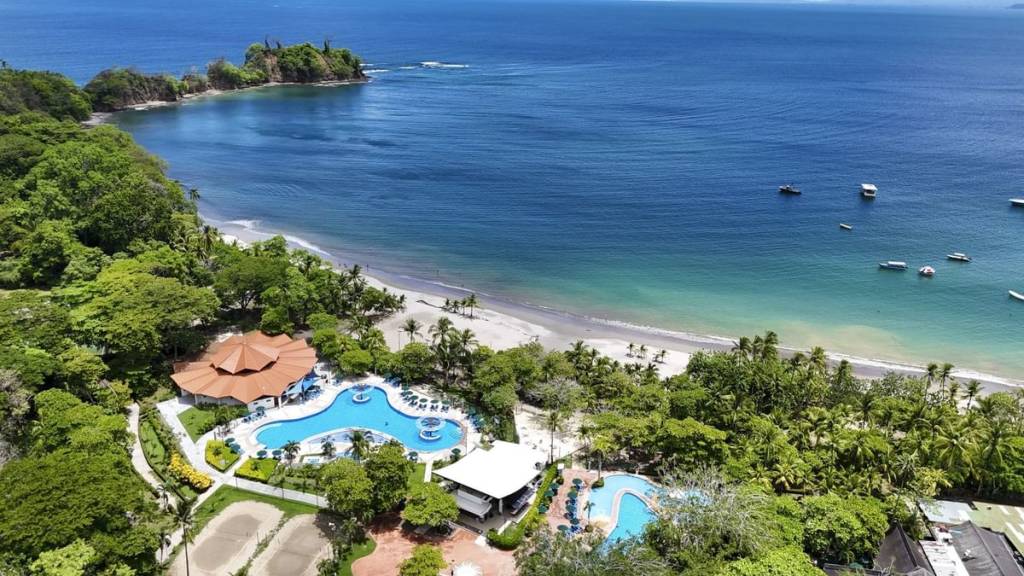
Recharge with a few relaxing nights by the beach and make your adventure feel even more extraordinary. Costa Rica’s coastline is a paradise of golden sands and warm Pacific waters, perfect for unwinding after wildlife encounters and rainforest exploration. Here are a few of our favourites to inspire your stay:
Si Como No Resort, Spa & Wildlife Refuge: Nestled above Manuel Antonio’s coastline, boasting jungle-to-ocean views and access to a private wildlife refuge. Its comfortable rooms, relaxing spa and proximity to Manuel Antonio National Park make it ideal for nature lovers wanting both comfort and adventure.
Alma del Pacífico Beachfront Hotel: A colourful, boutique beachfront escape set along Playa Esterillos, offering spacious villa-style rooms just steps from the sand. With an oceanfront spa, tropical gardens and a peaceful atmosphere, it’s perfect for travellers seeking tranquillity by the Pacific.
Punta Leona Beach Club & Nature Resort: Set within a private nature reserve, this resort has two beautiful white-sand beaches, swimming pools and wildlife-spotting opportunities. Monkeys roaming the grounds, sloths lazing in the trees, a butterfly garden, and free guided walks to spot toucans or hummingbirds.
This is just a glimpse of what’s possible. Speak to your sales representative, who can guide you through the options and arrange everything for you.
Accommodation
Hotels and jungle-wrapped lodges
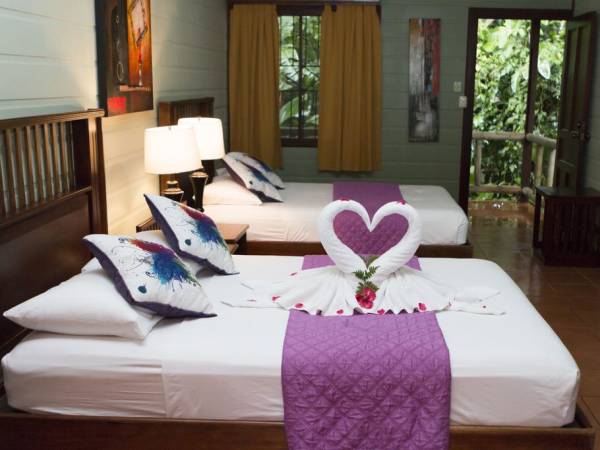
On this Costa Rican adventure, we spend 14 nights in hotels and lodges. Make sure to bring your swimwear, as most have swimming pools. The normal accommodations used on this trip are on the day-to-day itinerary; however, below are a couple of the notable places we stay.
Upgrade your room on Day 1, 7, 8, 9, 13 and 14 of the itinerary – speak to your sales representative for more details.
Savegre: Savegre Hotel & Spa or Trogon Lodge (nights 8-9)
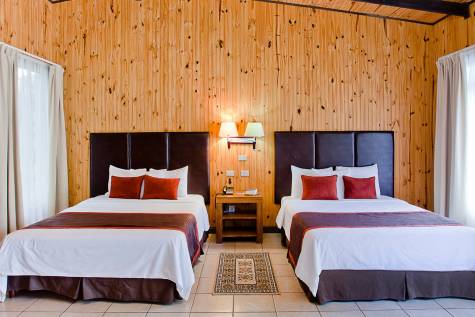
In the middle of a natural forest reserve, Savegre Hotel & Spa (above) is the ideal place to immerse in nature. It has plant-filled gardens, multiple walking trails, and a lookout point with views over forested slopes. We sleep in wooden lodges, while Las Bromelias restaurant serves international and local cuisines (made with seasonal, indigenous produce) and Los Robles, a bar-lounge, serves cocktails and Savegre coffee. On some departures, we stay at the 24-room Trogon Lodge instead. It’s equally idyllic, with a farm-to-table restaurant, a river-view bar and two nature trails.
Drake Bay: Drake Bay Wilderness Resort (nights 10-12)
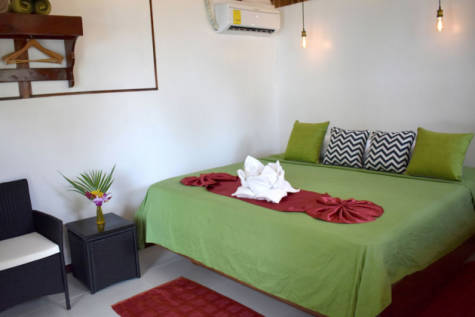
When Herbert and Marleny founded this resort in 1985, they were among the first in the area – electricity would take 20 years to fully arrive here. They chose an excellent location. Right by the ocean, there’s plenty of spots to admire the bay, while fellow residents include white-faced monkeys, anteaters and even dolphins. Other highlights include a restaurant serving Costa Rican-American dishes, a saltwater swimming pool, and a bar with bay views.
Worth knowing
- Some of the properties have ceiling fans rather than air conditioning.
- One or several of the named properties might be substituted for similar alternatives to secure hotel availability. Please discuss with your customer operations executive if you require more details regarding your specific departure date.
Single supplement from CAD 1890
Food & Drink
Hotel breakfasts are normally buffets, and lunches and dinners at Tortuguero are also buffets. Vegetarian and vegan options are limited but food is plentiful and tasty – please inform us before departure of any special dietary requests.
Costa Rican specialities include gallo pinto, a black bean and rice dish, which is a staple part of the local diet. Soups and stews are also common, and fresh fruit is abundant and will no doubt be one of the highlights of your time in the tropics.
Transport
Depending on the group size, we either use a 16-seat Coaster minibus or a larger 20-seat vehicle. Due to the type of vehicles we use, it’s common for luggage to be transported on the roof, covered by a tarpaulin.
- We travel in air-conditioned buses and boats in Tortuguero and Drake Bay. There is also a shared transfer to Tortuguero on Day 2 in a larger coach.
- During our stay at Savegre Lodge, transfers are in a Toyota pick-up, which may not have fitted seatbelts.
Weather & Seasonality
Costa Rica is 10 degrees north of the equator and has a tropical climate. The average annual temperature is around 26C (79F) in the lowlands and 10C (50F) in the highest mountain regions. However, it’s essential you prepare for the time of year in which your departure takes place.
Dry season (December to April): This is the driest period of the year and can get incredibly hot; on the Pacific side, temperatures may exceed 37C (98F). If passing through areas of dry tropical forest it can be hot, dusty and dry. Prepare for some rain even during this time of year.
Rainy season (May to November): Expect daily downpours, although these are usually quite short and there is still plenty of sunshine. Typically, there are sunny conditions until approximately 1pm-2pm and then a build-up of cloud from around 3pm, resulting in late afternoon rain (most likely showers between 3pm-5pm). Usually, the sky clears by 6pm.
Joining Instructions
Key information
Start hotels and phone number:
Park Inn, Avenida 6, San Bosco, CR-P, San José, 10103 (+506 4110 1100)
or
Presidente Hotel, Avenida Central, Catedral, San José, 11801 (+506 2010 0000)
Recommended arrival time: You can arrive at any time today, but we recommend by 6pm to join the optional welcome dinner at 7:30pm.
Airport: Juan Santamaria Airport (SJO)
Getting to the start hotel
The start hotel is approximately 30 to 60 minutes’ drive from the airport. We provide free arrival transfers to the start (or pre-tour) hotel from the airport for all customers arriving on the date the tour starts.
Catching your return flight
Exodus provides free departure transfers for all customers to Juan Santamaria Airport (SJO) from the end hotel.
Please note, unless specified otherwise, the transfers will be to the start (or pre-tour) hotel and from the end (or post-tour) hotel and will be on the date on which the tour starts/ends; transfers to other hotels in the same city and/or on different dates may attract an extra charge. Transfers should be booked with your sales representative at least two to three weeks before the tour starts. Transfers are available for any flight but can only be added to your booking once we have received your flight schedule.
Flying via the USA
The US is known to have lengthy immigration queues which must be navigated by all passengers, including those in transit. We only book flights that meet the minimum valid connection time and wherever possible we will ensure there is at least a two-hour window between connecting flights. If your flight to the US is delayed and the connection becomes particularly tight, we advise you to make your way as quickly as you can from the plane to immigration where you should make yourself known to an official in an attempt to move closer to the front of the queue.
Full joining instructions including local emergency numbers will be sent to you as part of our Final Joining Instructions. If you do not receive these at least a week before departure, or require them earlier please contact our office or your travel agent.
Location start: San José
Location end: San José
What To Take
Essential Equipment
- Quick-drying clothing
- Sunglasses
- Sunhat
- Sunscreen
- Waterproof poncho or waterproofs
- Warm sweater (for cloud forest)
- Waterproof walking shoes
- Swimwear
Please limit your luggage to one main suitcase/backpack per person (weighing no more than 50lb/23kg) and one piece of hand luggage. This is for the health and safety of our local team and due to the limited space and weight allowance on the transport.
Water included: Please bring a reusable bottle, as we provide safe drinking water throughout this adventure. Single-use plastic bottles are banned in Costa Rican national parks and we do not recommend drinking the tap water.
Optional Equipment
- Umbrella
- Camera
- Binoculars
- Torch (flashlight)
- Small backpack for walks
- Insect repellent
- Dark clothes if you plan to take the optional turtle excursion (seasonal)
- Re-usable fabric tote bag to avoid using unnecessary plastic bags
Spare space? If you have room in your luggage, consider bringing items to donate to schools and villages − your tour leader can assist in delivering them once you’ve arrived.
Much-need items included:
- School stationery, including pens, pencils, crayons, erasers, rulers and notebooks
- Card games
- Balls, including (deflated!) footballs and tennis balls
- Toiletries, including toothpaste, toothbrushes and soap
Practical Information
Passport
Remember to check the expiration date of your passport if travelling internationally. Many countries require your passport to be valid for at least six months after the date of your scheduled return.
Visa
Costa Rica
Travellers from the UK, US and EU normally do not need a visa to enter Costa Rica; however, proof of onward travel may be required – we suggest you take a physical copy of your flight details in case officials ask to see them.
Please note, visa requirements often change and it is your responsibility to obtain any required visas for this trip. Therefore, we recommend that you check with the nearest embassy or consulate of your chosen destination(s), including any countries you may be transiting or transferring through.
The following establishments provide visa advice for citizens of the named country,
- Australia: Smartraveller
- Canada: Travel Advice and Advisories, Government of Canada
- United Kingdom: Foreign, Commonwealth & Development Office (FCDO)
- USA: Bureau of Consular Affairs
If you are travelling via the USA and are eligible to transit under the Visa Waiver Program, you are required to register in advance for an ESTA (Electronic System for Travel Authorization). There is a US$21 charge, which is only payable online.
Please note: not all nationalities have the same eligibility for travel to or transit via the USA, and you may not be covered by the Visa Waiver Program. Regulations stipulate that any person who has travelled to Iran, Iraq, Libya, North Korea, Somalia, Sudan, Syria or Yemen since March 2011, or have dual nationalities of these countries, may no longer qualify. In addition, if you have travelled to Cuba since 12 January 2021 you will not be eligible for the visa waiver program and should instead apply for a visa.
If you are in doubt of your eligibility, please check the visa requirements with your local US embassy.
Vaccinations and Health
Costa Rica
There are no required vaccinations. However, you may want to consider vaccinations for tetanus, hepatitis A, rabies and typhoid. The risk of malaria is slight, but you may wish to consult your doctor or travel clinic for further advice.
Many travellers will also require a yellow fever vaccination certificate if arriving from a country with risk of yellow fever transmission, Tanzania and Zambia.
Dengue, Zika and Chikungunya are viral diseases spread by mosquitoes, are known risks in Costa Rica. There is currently no vaccine or prophylaxis available, so we strongly recommend you take the usual precautions to avoid mosquito bites.
Please check all requirements and travel vaccination recommendations with your doctor or travel clinic.
Methanol: The FCDO warns travellers to be cautious of methanol poisoning when travelling in destinations visited on the trip.
Local Time
Costa Rica's time zone: America/Costa_Rica (UTC -06:00)
Electricity
Costa Rica's electricity: Plug types A (two flat pins, US standard) and B (three pins, US standard) – 120V, 60Hz

Money
Costa Rica's currency: Costa Rican colon (CRC); however, US dollars are widely accepted
ATM Availability
ATMs are widely available in Costa Rica, particularly in the main tourist areas. A flat fee of up to US$$5-$7 and a small commission usually applies with debit card withdrawals. Mastercard and Visa are quite widely accepted in the bigger hotels, restaurants and tourist shops, though not, of course, in rural areas. Always check the handling fee when paying by credit card as it can be high. It is certainly much more convenient to carry as much of your money in cash as possible, so long as you are security conscious. We recommend that you bring some small denomination notes (US$1 and US$5 notes) since getting change is often a problem when paying for small items.
Extra Expenses & Spending Money
It is best to take US dollars to Costa Rica, as other currencies can be difficult to exchange and the rate can be poor. In practice, US dollars are widely accepted as payment in Costa Rica.
- Allow extra to cover the cost of meals not included in the price of the holiday. Snack lunches are approximately US$15-US$18 and evening meals US$25-US$32 per meal (excluding drinks).
- Average costs for drinks (in restaurants) are US$2-US$3 for mineral water or soft drinks, US$4-US$5 for a bottle of beer , US$7-US$10 for cocktails and US$7-US$10 for a glass of wine.
- There is an international departure tax on leaving San José at the end of the trip (approximately US$29) but this is subject to change and isn’t applicable for all airlines. At the time of writing, United and American Airlines include this tax in the cost of the ticket.
- Turtle nesting tour (July to October only) in Tortuguero – from approximately US$50 and can only be booked directly with the hotel at check-in.
- Optional snorkelling excursion in Cahuita: Two to three-hour tour by boat with equipment included from US$70 (activity depends on weather and tides).
- Optional Bri Bri Indigenous Reserve tour from approximately US$75.
Optional excursions can be paid for by cash, credit or debit card and can only be booked locally.
Tipping
Our local staff are paid fairly for their work. However, it is usual for groups to tip tour leaders and drivers, and it would be reasonable for each group member to contribute US$90 for the tour leader and US$65 for the driver. You may wish to tip more if travelling in a small group.
The tour leader may organise a tipping kitty to facilitate tips for other staff members including porters, local guides and restaurant waiting staff, which will be collected at the start of the trip. The amount may vary per departure, but we recommend a starting point of US$130 per group member.
Sustainability and Impact
As a certified B Corp, we’re on a mission to improve our social and environmental impact across all our adventures.
We do this through our innovative Thriving Nature, Thriving People plan.
This ‘nature positive’ approach is designed to help nature and communities thrive in harmony through practical solutions, such as reducing carbon and waste on our trips, supporting conservation projects through the Exodus Adventure Travels Foundation, and rewilding 100 square metres for every Exodus traveller.
You’ll also find Thriving Nature, Thriving People moments across our trips. These experiences are often a highlight of your adventure, while also benefiting the natural world or local communities.
On this trip, we:
- Team up with an expert for a behind-the-scenes tour of CATIE, a world-renowned institute for biological conservation, and gain a deep understanding of the natural world and the myriad plants studied there.
Important Information
Optional activities and excursions
If you would like to join an optional activity or excursion outside those listed in the itinerary, your leader may be able to assist with selecting a provider. However, Exodus has not assessed the safety standards of activities or excursions that are not listed in the Trip Notes. All optional activities or excursions are undertaken at your own risk.
Important Information
Your Safe Participation
When booking this trip, you should be confident in your ability to participate in all activities described in these Trip Notes. If you have any doubt about your suitability, please call us and ask to speak to one of the experts on this itinerary.
Although our leaders are well trained to deal with different capabilities, if they have any concerns about someone’s ability to safely take part in an activity, or their impact on other people’s enjoyment, we authorise them to take necessary action which, in some circumstances, may involve asking someone to miss that activity.
By booking this trip you agree to our Booking Conditions which clearly state that our leaders have the authority to do this. In these rare instances we will ensure anyone sitting out is safely provided for and offered alternative options where possible. Refunds will not be provided for activities missed and customers may be liable for additional costs incurred.
Seatbelts
All vehicles used by us should be equipped with working seatbelts, except where approved by us based on the vehicle type or journey. Wherever seatbelts are available, we require our customers to use them for their own safety, even where it may not be a legal requirement.
Travel Safety
For additional information please have a look at the travel safety advice page on our website.
How to Book
Speak to our friendly team of experts to plan your adventure:
- Check availability: our website shows real-time availability of our guided group tours, or contact our team by phone, email or live chat.
- Hold a space: You can provisionally hold a space on any guided group tour to give you time to finalise your travel plans.
- Confirm your booking: Payment of a deposit will complete your booking and secure your place on the trip.
After booking
You will receive a confirmation document and invoice, which includes extra information and guidance about your travel arrangements. Our dedicated Customer Operations team will help you with any pre-travel questions or arrangements and can easily add extensions or extra accommodation to your booking. Final Joining Instructions will usually be sent out two to three weeks prior to departure.
Adding transfers to your booking
If you have arranged your own flights and would like to add transfers to your booking, please provide your arrival and departure details to our Customer Operations team around four to six weeks before departure.
- Where free transfers are included, they are available for any flight but can only be added to your booking once we have received your flight schedule.
- Where group arrival and departure transfers are available, these operate at fixed times. You will need to arrive in time to meet the scheduled transfer. If the timings don’t align with your travel plans, our team can arrange private transfers once they receive your flight schedule.
Trip Note validity
Trip notes may be updated after booking; if any updates significantly impact the inclusions or itinerary you will be advised in writing. A link to the most up-to-date Trip Notes will be sent out with your Final Joining Instructions before departure.
The information in these Trip Notes is given in good faith. All holidays can be subject to unexpected changes, and occasionally it may not be possible to follow the itinerary as planned. In these circumstances we will make the best-possible alternative arrangements that maintain the integrity of the original itinerary.

